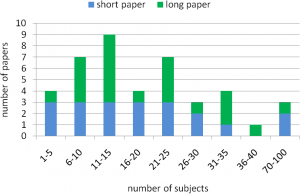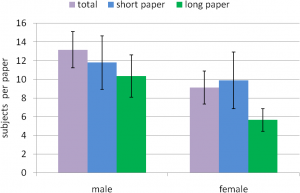Yesterday I started to prepare my MobileHCI tutorial. It is basically about doing studies with a large number of subjects (e.g. >1,000) and therefore I started to wonder how many subjects participate in the average mobile HCI study. But first of all, what is MobileHCI anyway?
“MobileHCI provides a forum for academics and practitioners to discuss the challenges, potential solutions and innovations towards effective interaction with mobile systems and services. The conferences cover the analysis, design, evaluation and application of human-computer interaction techniques and approaches for all mobile computing devices, software and services.” [1]
Collected Data
Using the DBLP I fetched all short and long papers that have been presented at MobileHCI 2010. 20 short papers and 23 long papers have been accepted and the acceptance rate was about 20% [2].
For each paper I determined the total number of subjects that took part in the conducted studies. In fact, there is only one paper that comes without a study that involves human subjects. In addition, I tried to determine the number of male and female subjects as well as their age. Unfortunately, not all papers report participants’ age and gender. In [3] for example they conducted a study with 40 participants but I couldn’t find any information about their age or gender. Other papers only report participants’ age but not their gender (e.g. [4]). The way subjects’ age is reported is very inconsistent across the papers. [5,6], for example, give a range (e.g. “18 to 65 years”) while other papers provide more information (e.g. [7] reports that “Twenty university students (10 female and 10 male) aged between 23 and 34 (M=27.35, SD=3.10) participated in the study.”). I tried to guess or compute unclear details if I felt the paper provide enough information for doing that.
Number of subjects
Overall, the average number of subjects per paper is M=21.49 (SD=19.99). For short papers the average number of subjects is M=23.20 (SD=24.95) and for long papers it is M=20.00 (SD=14.83). The chart below shows the histogram of the distribution.
Subjects’ gender
As described above it wasn’t always easy (or possible) to determine the subjects’ gender. Based on the provided data 474 males, 328 females, and 106 people with an unknown gender participated in the studies. That makes M=13.17 males (SD=11.59) and M=9.11 females (SD=10.63) per paper that reports the gender. The chart below shows the subjects’ gender for short and long papers. The error bars show one standard error.
Out of curiosity, I tested if the amount of guys and girls is significantly different. A simple paired t-test (probably not the best tool for such a post-hoc test) shows that significantly more males than females participated in the studies (p<.001, d=0.37). The difference is also significant for long papers (p<.01, d=0.57) but not for short papers (p=0.13, d=0.14).
So what?
From the analysis I learned that a number of papers only briefly describe their participants and not all report participants’ age and gender. Large-scale studies are obviously not common in the community. Half the papers conducted studies with 20 or less participants and there are only three papers with more than 40 participants. With 30% more males than females the sample is clearly biased towards male participants. I, however, must admit that a large and perfect sample of the population is not always necessary. [8] is a nice example of an ethnographic study and I guess no one would complain about the small biased sample. I might talk about the different kinds of studies that are conducted next time.
References
[1] The International Conference Series on Human Computer Interaction with Mobile Devices and Services website
[2] MobileHCI 2010 notification of acceptance email.
[3] Jarmo Kauko and Jonna Häkkilä: Shared-screen social gaming with portable devices. Proc. MobileHCI, 2010.
[4] Ming Ki Chong, Gary Marsden, and Hans Gellersen: GesturePIN: using discrete gestures for associating mobile devices. Proc. MobileHCI, 2010.
[5] Simon Robinson, Matt Jones, Parisa Eslambolchilar, Roderick Murray-Smith, and Mads Lindborg: “I did it my way”: moving away from the tyranny of turn-by-turn pedestrian navigation. Proc. MobileHCI, 2010.
[6] Yolanda Vazquez-Alvarez, and Stephen A. Brewster: Designing spatial audio interfaces to support multiple audio streams. Proc. MobileHCI, 2010.
[7] Alessandro Mulloni, Andreas Dünser, and Dieter Schmalstieg: Zooming interfaces for augmented reality browsers. Proc. MobileHCI, 2010.
[8] Marianne Graves Petersen, Aviaja Borup Lynggaard, Peter Gall Krogh, and Ida Wentzel Winther: Tactics for homing in mobile life: a fieldwalk study of extremely mobile people. Proc. MobileHCI, 2010.


Pingback: Analysis of User Studies at MobileHCI 2011 « Things about stuff